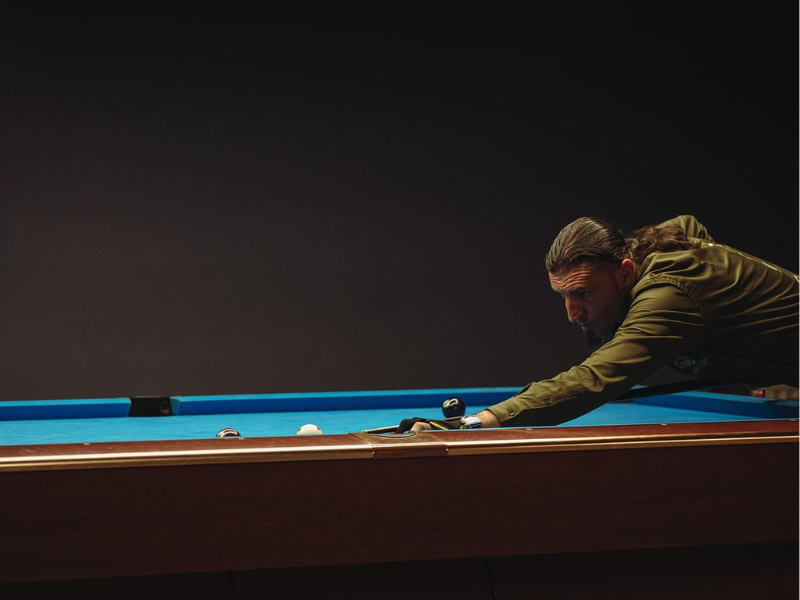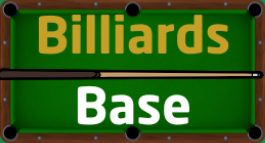Choosing the right pool table size is one of the most critical decisions you’ll make when setting up a game room or purchasing your first table.
Understanding standard pool table dimensions affects everything from your gameplay experience to room layout, installation requirements, and long-term enjoyment of the game.
What is a Standard Pool Table Size?

American pool tables come in three official regulation sizes, each serving different purposes and venues:
7-Foot Tables (Bar/Pub Size)
- Playing surface: 78″ × 39″ (198cm × 99cm)
- Total footprint: Approximately 93″ × 54″ (236cm × 137cm)
- Common use: Bars, pubs, smaller game rooms
8-Foot Tables (Home Size)
- Playing surface: 88″ × 44″ (224cm × 112cm)
- Total footprint: Approximately 103″ × 59″ (262cm × 150cm)
- Common use: Home recreation rooms, casual play
9-Foot Tables (Tournament/Professional Size)
- Playing surface: 100″ × 50″ (254cm × 127cm)
- Total footprint: Approximately 115″ × 65″ (292cm × 165cm)
- Common use: Professional tournaments, serious players, larger game rooms
| Table Size | Playing Surface | Total Footprint | Recommended Room Size |
| 7-foot | 78″ × 39″ | 93″ × 54″ | 17′ × 13.5′ |
| 8-foot | 88″ × 44″ | 103″ × 59″ | 18′ × 14′ |
| 9-foot | 100″ × 50″ | 115″ × 65″ | 19′ × 15′ |
According to the World Pool-Billiard Association (WPA), the 9-foot table is the official tournament standard for most professional American pool games, including 8-ball and 9-ball.
Full Table Dimensions Explained (Playing Area & Overall Footprint)

Understanding pool table measurements requires knowing what exactly gets measured and why these specifications matter for gameplay.
Playing Surface vs. Total Footprint
The playing surface refers to the cloth-covered slate area between the inside edges of the cushions, this is where the balls actually roll. The total footprint includes the rails, pockets, and any overhanging elements.
Key Dimensional Standards
- Width-to-length ratio: Always 2:1 for regulation tables
- Playing surface height: 29.25″ to 31″ (74-79cm) from floor to slate
- Rail height: Approximately 2.5″ (6.35cm) above playing surface
- Pocket openings: 4.5″ to 5.125″ (11.4-13cm) depending on table type
Construction Elements That Affect Size
- Rails/cushions: Add approximately 7-8″ to each side of playing surface
- Pockets: Corner and side pockets extend slightly beyond rail line
- Aprons: The decorative skirt beneath the table, typically 3-4″ wide
Minimum Room Size Needed for Each Table
Calculating proper room dimensions involves more than just the table footprint—you need adequate cueing space around the entire perimeter.
Standard Cue Length Considerations
Most pool cues measure 58″ (147cm), which means you need at least 5 feet of clearance on all sides for comfortable play. However, walls, furniture, and room layout can affect these requirements.
Recommended Room Dimensions
For 7-foot tables:
- Minimum: 17′ × 13.5′ (518cm × 411cm)
- Comfortable: 18′ × 14.5′ (549cm × 442cm)
- Ideal: 19′ × 15.5′ (579cm × 472cm)
For 8-foot tables:
- Minimum: 18′ × 14′ (549cm × 427cm)
- Comfortable: 19′ × 15′ (579cm × 457cm)
- Ideal: 20′ × 16′ (610cm × 488cm)
For 9-foot tables:
- Minimum: 19′ × 15′ (579cm × 457cm)
- Comfortable: 20′ × 16′ (610cm × 488cm)
- Ideal: 21′ × 17′ (640cm × 518cm)
Space-Saving Solutions for Tight Rooms
If your room falls short of ideal dimensions, consider these alternatives:
- Shorter cues: 48″, 52″, or 54″ cues for specific wall shots
- Wall-mounted cue racks: Maximize available floor space
- Strategic furniture placement: Position low furniture (under 30″) near table walls
- Removable/foldable accessories: Chairs and accessories that can be moved during play
Other Pool Table Sizes & Variations
Beyond the three standard regulation sizes, you’ll encounter several variations in the market:
Smaller Tables (6-foot and under)
- 6-foot tables: 72″ × 36″ playing surface, suitable for children or very tight spaces
- Mini/toy tables: Various sizes, typically not suitable for serious play
- Convertible tables: Dining tables that convert to pool tables, usually 7-foot or smaller
Larger Tables (10-foot and above)
- 10-foot tables: 112″ × 56″ playing surface, rare and requiring massive room space
- 12-foot snooker tables: Not technically pool tables, but sometimes confused by buyers
Commercial Variations
- Coin-operated tables: Often slightly smaller than standard due to mechanism housing
- Bar tables: May vary from true 7-foot regulation due to space constraints
- Outdoor tables: Weather-resistant versions, typically available in 7-foot and 8-foot sizes
International Differences
While this guide focuses on American pool, it’s worth noting that English pool tables are significantly smaller (typically 6′ × 3′ or 7′ × 3.5′) and use different pocket specifications and ball sizes.
Factors to Consider When Buying a Pool Table
Space and Installation Requirements
Room assessment checklist:
- Measure your available space including ceiling height (minimum 8 feet recommended)
- Check doorway widths and stairway access for delivery
- Consider HVAC vents and lighting placement
- Account for electrical outlets for table lighting
Intended Usage
Family recreation:
- 7-foot or 8-foot tables work well for most households
- Prioritize durability and safety features
- Consider tables with ball return systems
Serious/competitive play:
- 9-foot tables provide tournament-standard experience
- Invest in higher-quality slate and cushion materials
- Ensure proper lighting setup
Commercial use:
- Durability and vandal-resistance become priorities
- Consider coin-operated mechanisms
- Factor in higher insurance and maintenance costs
Construction Quality Factors
Slate considerations:
- Three-piece slate: Industry standard, easier installation
- One-piece slate: More stable but difficult to move
- Slate thickness: ¾” minimum, 1″ preferred for better play
Frame and leg construction:
- Solid hardwood preferred over particle board
- Proper bracing and leveling mechanisms
- Weight capacity (quality tables weigh 700-1000+ pounds)
Access and Assembly Planning
Before purchasing, verify:
- Can the table fit through all doorways in its delivery path?
- Are there stairs or tight turns that could prevent delivery?
- Do you have adequate tools and help for assembly?
- Is professional installation included or available?
FAQs
How big is a standard pool table for American pool?
A standard American pool table comes in three regulation sizes: 7-foot (78″ × 39″ playing surface), 8-foot (88″ × 44″), and 9-foot (100″ × 50″). The 9-foot table is considered the official tournament standard by the World Pool-Billiard Association.
Is there a difference between 8 ft and 9 ft tables in play?
Yes, the larger 9-foot table significantly changes gameplay dynamics. Shots require more precision, bank shots travel longer distances, and position play becomes more challenging. Most professional tournaments use 9-foot tables, making them the preferred choice for serious players wanting to practice under tournament conditions.
What’s the smallest table I can buy and still play real pool?
A 7-foot table is the smallest regulation size that maintains proper 2:1 proportions and standard pocket specifications. While 6-foot tables exist, they compromise gameplay quality and don’t provide adequate practice for regulation play. For authentic pool experience, stick with 7-foot minimum.
How much space should I leave around my pool table?
Allow at least 5 feet of clearance on all sides for standard 58″ cues. This means minimum room dimensions of 17′ × 13.5′ for a 7-foot table, 18′ × 14′ for an 8-foot table, and 19′ × 15′ for a 9-foot table. Add 1-2 feet to each dimension for comfortable play.
Are all “bar size” tables the same?
Not exactly. While most bar tables are 7-foot regulation size, some venues use slightly smaller tables due to space constraints. Additionally, coin-operated bar tables may have different pocket configurations and slightly altered dimensions to accommodate the coin mechanism. Always verify actual measurements when comparing.
Select the Right Pool Table Size for You
Selecting the right pool table size depends on balancing your available space, intended usage, and budget considerations. Remember these key takeaways:
- Measure twice, buy once: Accurate room measurements prevent costly mistakes
- Bigger isn’t always better: An 8-foot table in a properly sized room plays better than a 9-foot table in cramped quarters
- Quality matters: Invest in proper slate construction and quality materials within your size constraints
- Professional guidance helps: Consider consulting with dealers about installation and room setup
Ready to Take the Next Step?
- Measure your space using the guidelines in this article
- Research specific table models that fit your size requirements
- Visit showrooms to experience different table sizes firsthand
- Plan for accessories including proper lighting, cues, and storage
For more detailed buying guidance, explore our related articles on Best Pool Tables for Home Use and How to Choose Pool Balls: Size, Material, Brands. When you’re ready to complete your setup, don’t miss our guide on Pool vs. Snooker Cues: Key Differences & Buying Tips.
Have questions about pool table sizing not covered here? Leave a comment below and someone in the community will answer you…eventually.
